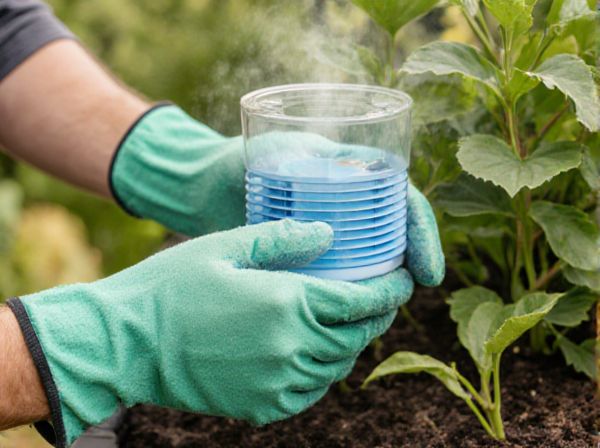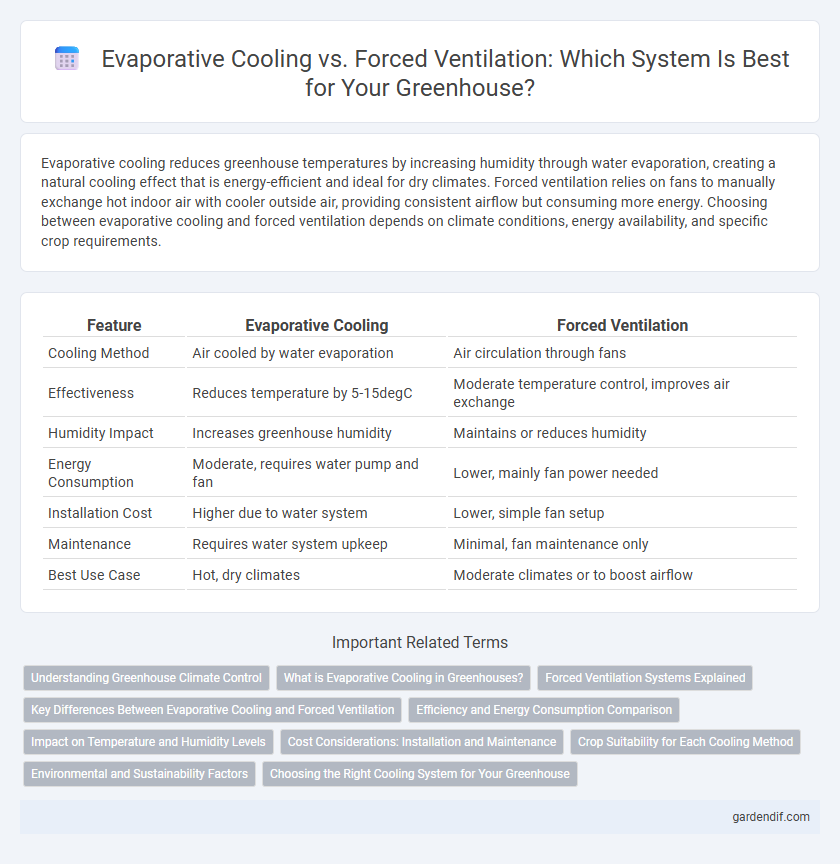
Evaporative Cooling vs Forced Ventilation Illustration
Evaporative cooling reduces greenhouse temperatures by increasing humidity through water evaporation, creating a natural cooling effect that is energy-efficient and ideal for dry climates. Forced ventilation relies on fans to manually exchange hot indoor air with cooler outside air, providing consistent airflow but consuming more energy. Choosing between evaporative cooling and forced ventilation depends on climate conditions, energy availability, and specific crop requirements.
Table of Comparison
| Feature | Evaporative Cooling | Forced Ventilation |
|---|---|---|
| Cooling Method | Air cooled by water evaporation | Air circulation through fans |
| Effectiveness | Reduces temperature by 5-15degC | Moderate temperature control, improves air exchange |
| Humidity Impact | Increases greenhouse humidity | Maintains or reduces humidity |
| Energy Consumption | Moderate, requires water pump and fan | Lower, mainly fan power needed |
| Installation Cost | Higher due to water system | Lower, simple fan setup |
| Maintenance | Requires water system upkeep | Minimal, fan maintenance only |
| Best Use Case | Hot, dry climates | Moderate climates or to boost airflow |
Understanding Greenhouse Climate Control
Evaporative cooling reduces greenhouse temperatures by increasing humidity and lowering air temperature through water evaporation, making it effective in hot, dry climates. Forced ventilation uses fans to circulate air, removing excess heat and humidity while promoting uniform temperature distribution, suitable for a variety of greenhouse environments. Optimizing greenhouse climate control often combines both methods to maintain ideal growing conditions, balancing temperature, humidity, and air quality for enhanced plant health.
What is Evaporative Cooling in Greenhouses?
Evaporative cooling in greenhouses utilizes the natural process of water evaporation to lower air temperature and increase humidity, improving plant growth conditions. This method involves passing warm air through wet pads or sprays, causing water to evaporate and absorb heat, which effectively cools the environment. It is energy-efficient and ideal for maintaining optimal temperature and humidity levels in hot, dry climates.
Forced Ventilation Systems Explained
Forced ventilation systems in greenhouses use fans and ductwork to actively circulate air, ensuring consistent temperature and humidity control for optimal plant growth. These systems effectively remove excess heat, carbon dioxide, and humidity by creating a continuous airflow that stabilizes the internal environment. Unlike evaporative cooling, forced ventilation does not rely on water evaporation, making it a suitable choice for regions with high humidity or limited water resources.
Key Differences Between Evaporative Cooling and Forced Ventilation
Evaporative cooling reduces temperature by passing air through wet pads, leveraging water evaporation to lower heat and increase humidity, ideal for hot, dry climates. Forced ventilation relies on fans to circulate air and remove heat, without altering humidity levels, making it suitable for controlling temperature and air quality in various conditions. Key differences include evaporative cooling's reliance on water for heat reduction versus forced ventilation's mechanical air movement for heat and pollutant removal.
Efficiency and Energy Consumption Comparison
Evaporative cooling systems in greenhouses are highly energy-efficient, using up to 70% less electricity than forced ventilation by leveraging water evaporation to reduce temperatures naturally. Forced ventilation relies on high-power fans that consume significant energy to maintain airflow but may provide faster temperature regulation in certain conditions. Evaluating greenhouse climate control solutions requires balancing the lower operational costs and environmental benefits of evaporative cooling against the rapid response and flexibility offered by forced ventilation systems.
Impact on Temperature and Humidity Levels
Evaporative cooling significantly lowers greenhouse temperature by increasing humidity through the evaporation process, which helps maintain optimal growing conditions for plants that thrive in moist environments. Forced ventilation primarily controls temperature by exchanging hot indoor air with cooler outside air, leading to reduced humidity levels that favor crops sensitive to excessive moisture. Understanding these mechanisms allows growers to tailor climate management strategies to balance temperature reduction and humidity control based on specific crop requirements.
Cost Considerations: Installation and Maintenance
Evaporative cooling systems in greenhouses typically involve lower initial installation costs due to simpler technology and fewer mechanical components compared to forced ventilation systems, which require fans and ductwork. Maintenance expenses for evaporative cooling center around regular pad replacement and water treatment, while forced ventilation demands periodic fan servicing, electrical upkeep, and potential motor replacements, often leading to higher long-term costs. Evaluating total cost of ownership favors evaporative cooling in hot, dry climates, whereas forced ventilation may incur higher expenses but offers greater control in diverse environmental conditions.
Crop Suitability for Each Cooling Method
Evaporative cooling is ideal for crops requiring high humidity and moderate temperatures, such as lettuce, spinach, and herbs, as it adds moisture to the air while lowering temperatures. Forced ventilation suits heat-tolerant crops like tomatoes, peppers, and cucumbers by providing effective air circulation without increasing humidity, preventing fungal diseases. Selecting the appropriate cooling method based on crop humidity and temperature tolerances enhances plant growth and yield in greenhouse environments.
Environmental and Sustainability Factors
Evaporative cooling reduces energy consumption by using natural water evaporation to lower temperatures, significantly decreasing greenhouse gas emissions compared to forced ventilation systems that rely on electricity-driven fans. This sustainable method enhances humidity control, benefiting plant growth while conserving water through recirculation techniques, unlike forced ventilation which often contributes to higher energy demand and carbon footprint. Optimizing environmental impact involves integrating evaporative cooling with renewable energy sources to further minimize ecological disturbance in greenhouse operations.
Choosing the Right Cooling System for Your Greenhouse
Evaporative cooling systems use water evaporation to lower air temperature, making them ideal for dry climates and large greenhouses with high heat loads. Forced ventilation relies on fans to circulate air, offering more precise temperature and humidity control, especially beneficial in humid environments or smaller greenhouses. Selecting the right cooling system depends on your greenhouse's size, local climate, and specific crop requirements to optimize growing conditions and energy efficiency.
Evaporative Cooling vs Forced Ventilation Infographic

 gardendif.com
gardendif.com